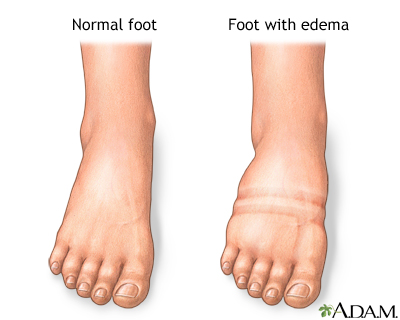Painless swelling of the feet and ankles is a common problem, especially among older people.
Abnormal buildup of fluid in the ankles, feet, and legs can cause swelling. This fluid buildup and swelling is called edema.

Considerations
Painless swelling may affect both legs and may include the calves or even the thighs. The effect of gravity makes the swelling most noticeable in the lower part of your body.
Home Care
Some tips that may help reduce swelling:
- Put your legs on pillows to raise them above your heart while lying down.
- Exercise your legs. This helps pump fluid from your legs back to your heart.
- Follow a low-salt diet, which may reduce fluid buildup and swelling.
- Wear support stockings (sold at most drugstores and medical supply stores).
- When traveling, take breaks often to stand up and move around.
- Avoid wearing tight clothing or garters around your thighs.
- Lose weight if you need to.
Never stop taking any medicines you think may be causing swelling without first talking to your health care provider.
When to Contact a Medical Professional
Call 911 or the local emergency number if:
- You feel short of breath.
- You have chest pain, especially if it feels like pressure or tightness.
Contact your provider right away if:
- You have heart disease or kidney disease and the swelling gets worse.
- You have a history of liver disease and now have swelling in your legs or abdomen.
- Your swollen foot or leg is red or warm to the touch.
- You have a fever.
- You are pregnant and have more than just mild swelling or have a sudden increase in swelling.
- You have new or worsened swelling in only one leg.
Also contact your provider if self-care measures do not help or swelling gets worse.
What to Expect at Your Office Visit
Your provider will take a medical history and do a thorough physical examination, paying special attention to your heart, lungs, abdomen, lymph nodes, legs, and feet.
Your provider will ask questions such as:
- What body parts swell? Your ankles, feet, legs? Above the knee or below?
- Do you have swelling at all times or is it worse in the morning or evening?
- What makes your swelling better?
- What makes your swelling worse?
- Does the swelling get better when you raise your legs?
- Have you had blood clots in your legs or lungs?
- Have you had varicose veins?
- What other symptoms do you have?
Diagnostic tests that may be done include:
- Blood tests, such as a complete blood count (CBC) or blood chemistry
- Chest x-ray or extremity x-ray
- Doppler ultrasound examination of your leg veins
- Electrocardiogram (ECG)
- Urinalysis
Your treatment will focus on the cause of the swelling. Your provider may prescribe diuretics to reduce the swelling, but these can have side effects. Home treatment for leg swelling that is not related to a serious medical condition should be tried before drug therapy.
Alternative Names
Swelling of the ankles - feet - legs; Ankle swelling; Foot swelling; Leg swelling; Edema - peripheral; Peripheral edema
Images
References
Magee DJ, Manske RC. Lower leg, ankle, and foot. Magee DJ, Manske RC, eds. Orthopedic Physical Assessment. 7th ed. St Louis MO: Elsevier; 2021:chap 13.
Quick CRG, Biers SM, Arulampalam THA. Pathophysiology, clinical features and diagnosis of vascular disease affecting the limbs. In: Quick CRG, Biers SM, Arulampalam THA, eds. Essential Surgery: Problems, Diagnosis and Management. 6th ed. Philadelphia, PA: Elsevier; 2020:chap 40.
Seller RH, Symons AB. Swelling of the legs. In: Seller RH, Symons AB, eds. Differential Diagnosis of Common Complaints. 7th ed. Philadelphia, PA: Elsevier; 2018:chap 31.
Review Date 6/20/2023
Updated by: Jacob Berman, MD, MPH, Clinical Assistant Professor of Medicine, Division of General Internal Medicine, University of Washington School of Medicine, Seattle, WA. Also reviewed by David C. Dugdale, MD, Medical Director, Brenda Conaway, Editorial Director, and the A.D.A.M. Editorial team.









